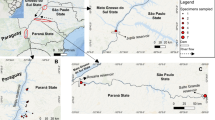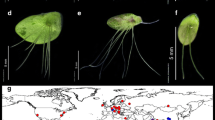Abstract
Duckweeds are a family of aquatic flowering plants that have a high potential for environmental remediation and biofuel manufacture. Two hundred and twenty clones of duckweeds were collected in Hainan Island, China. Based on morphological and phylogenetic analyses of the chloroplast ribosomal protein S16 intron (rps16) and atpF-atpH intergenic spacer sequences, these clones were classified into four species belonging to four genera: Lemna aequinoctialis, Spirodela polyrhiza, Wolffia globosa, and Landoltia punctata. Eight community types including single-, bi-, and/or tri-species communities were observed. L. aequinoctialis was the most widely distributed of the four species. W. globosa has the highest genetic diversity followed by L. aequinoctialis, whereas S. polyrhiza and L. punctata did not show any significant diversity. Duckweeds collected from the south of Hainan had higher diversity than those from the north. Moreover, very high rates of transversional nucleotide substitutions were found in the rps16 sequences of L. aequinoctialis and W. globosa, which make these duckweeds special with respect to nucleotide substitutions.



Similar content being viewed by others
References
Alvarado, S., M. Guedez, M. P. Lue-Meru, G. Nelson, A. Alvaro, A. C. Jesus & Z. Gyula, 2008. Arsenic removal from waters by bioremediation with the aquatic plants Water Hyacinth (Eichhornia crassipes) and Lesser Duckweed (Lemna minor). Bioresource Technology 99(17): 8436–8440.
Appenroth, K.-J., N. Borisjuk & E. Lam, 2013. Telling duckweed apart: genotyping technologies for the Lemnaceae. Chinese Journal of Applied Environmental Biology 19(1): 1–10.
Bog, M., H. Baumbach, U. Schween, F. Hellwig, E. Landolt & K.-J. Appenroth, 2010. Genetic structure of the genus Lemna L. (Lemnaceae) as revealed by amplified fragment length polymorphism. Planta 232(3): 609–619.
Bog, M., P. Schneider, F. Hellwig, S. Sachse, E. Z. Kochieva, E. Martyrosian, E. Landolt & K. J. Appenroth, 2013. Genetic characterization and barcoding of taxa in the genus Wolffia Horkel ex Schleid. (Lemnaceae) as revealed by two plastidic markers and amplified fragment length polymorphism (AFLP). Planta 237(1): 1–13.
Cheng, J. J. & A.-M. Stomp, 2009. Growing duckweed to recover nutrients from wastewaters and for production of fuel ethanol and animal feed. CLEAN – Soil, Air Water 37(1): 17–26.
Collins, D. W. & T. H. Jukes, 1994. Rates of transition and transversion in coding sequences since the human-rodent divergence. Genomics 20(3): 386–396.
Debusk, T. A., J. H. Ryther, M. D. Hanisak & L. D. Williams, 1981. Effects of seasonality and plant density on the productivity of some fresh water macrophytes. Aquatic Botany 10: 133–142.
Diao, Z. S., 1990. Aquatic weeds of China. Chongqing Press, Chongqing. (in Chinese).
Eid, M. A. A., M. A. E. Kandil, E. B. Moursy & G. E. M. Sayed, 1992. Effect of the duckweed, Lemna minor vegetations on the mosquito Culex pipiens pipiens. Insect Science and its Applications 13: 357–361.
Ge, X., N. Zhang, G. C. Phillips & J. Xu, 2012. Growing Lemna minor in agricultural wastewater and converting the duckweed biomass to ethanol. Bioresource Technology 124: 485–488.
Hoagland, D. R. & D. I. Arnon, 1950. The water-culture method for growing plants without soil. California Agricultural Experiment Station Circular 347: 1–32.
Hou, W., X. Chen, G. Song, Q. Wang & C. Chi Chang, 2007. Effects of copper and cadmium on heavy metal polluted waterbody restoration by duckweed (Lemna minor). Plant Physiology and Biochemistry 45(1): 62–69.
Iqbal, S., 1999. Duckweed Aquaculture: Potentials, Possibilities and Limitations for Combined Wastewater Treatment and Animal Feed Production in Developing Countries. SANDEC, Duebendorf, Switzerland, Report No. 6/99.
Jordan, W. C., M. W. Courtney & J. E. Neigel, 1996. Low levels of intraspecific genetic variation at a rapidly evolving chloroplast DNA locus in North American duckweeds (Lemnaceae). American Journal of Botany 83(4): 430–439.
Lüönd, A., 1983. Das wachstum von wasserlinsen (Lemnaceae) in Abhaengigkeit des Naehrstoffangebots, insbesondere phosphor und stickstoff, Vol. 3. Veroeffentlichungen des Geobotanischen Instutes der ETH, Stiftung Ruebel, Zurich, Biosystematic investigations in the family of duckweeds (Lemnaceae).
Landolt, E., 1980. Biosystematic investigations in the family of duckweeds (Lemnaceae). Vol. 1. Key to determination, Vol. 1. Veroeffentlichungen des Geobotanischen Institutes der ETH, Stiftung Ruebel, Zürich, 13–21.
Landolt, E., 1986. Biosystematic investigations in the family of duckweeds (Lemnaceae), Vol. 2: The family of Lemnaceae: a monographic study. – Morphology, karyology, ecology, geographic distribution, nomenclature, descriptions. Eidgenössische Technische Hochschule Zürich, Zürich.
Landolt, E. & R. Kandeler, 1987. Biosystematic investigations in the family of duckweeds (Lemnaceae), Vol. 4: The family of Lemnaceae: a monographic study. Eidgenössische Technische Hochschule Zürich, Zürich.
Les, D. H., D. J. Crawford, E. Landolt, J. D. Gabel & R. T. Kimball, 2002. Phylogeny and systematics of Lemnaceae, the duckweed family. Systematic Botany 27(2): 221–240.
Li, T., 2002. Annual variation of meteorological radiation in Hainan Island. Chinese Journal of Environment and Meteology 11: 45–48.
Li, H. Q., 2010. A hand manual on classification of spermatophytes in east China. Huadong Normal University Press, Shanghai.
Librado, P. & J. Rozas, 2009. DnaSP v5: a software for comprehensive analysis of DNA polymorphism data. Bioinformatics 25(11): 1451–1452.
Lu, Z. C., H. B. Sun, F. H. Wan, J. Y. Guo & G. F. Zhang, 2013. High variation in single nucleotide polymorphisms (SNPs) and insertions/deletions (Indels) in the highly invasive Bemisia tabaci (Gennadius) (Hemiptera: Aleyrodidae) Middle East-Asia Minor 1 (MEAM1). Neotropical Entomology 42: 521–526.
Mkandawire, M. & E. G. Dudel, 2005. Accumulation of arsenic in Lemna gibba L. (duckweed) in tailing waters of two abandoned uranium mining sites in Saxony, Germany. The Science of the Total Environment 336(1–3): 81–89.
Nhapi, I., J. Dalu, J. Ndamba, M. A. Siebel & H. J. Gijzen, 2003. An evaluation of duckweed-based pond systems as an alternative option for decentralised treatment and reuse of wastewater in Zimbabwe. Water Science Technology 48(2): 323–330.
Ozengin, N. & A. Elmaci, 2007. Performance of duckweed (Lemna minor L.) on different types of wastewater treatment. Journal of Environmental Biology/Academy of Environmental Biology, India 28(2): 307–314.
Shaw, J., E. B. Lickey, J. T. Beck, S. B. Farmer, W. Liu, J. Miller, K. C. Siripun, C. T. Winder, E. E. Schilling & R. L. Small, 2005. The tortoise and the hare II: relative utility of 21 noncoding chloroplast DNA sequences for phylogenetic analysis. American Journal of Botany 92(1): 142–166.
Shen, G. X., H. Hu, D. S. Shen & Y. M. Zhu, 2004. Growing conditions of five species of duckweed for nutrient-rich wastewater treatment (in Chinese). Transactions of the CSAE 20(1): 284–287.
Short, M. D., N. J. Cromar, J. B. Nixon & H. J. Fallowfield, 2007. Relative performance of duckweed ponds and rock filtration as advanced in-pond wastewater treatment processes for upgrading waste stabilisation pond effluent: a pilot study. Water Science Technology 55(11): 111–119.
Sree, K. S. & K.-J. Appenroth, 2014. Increase of starch accumulation in the duckweed Lemna minor under abiotic stress. Albanian Journal of Agricultural Sciences 13: 11–14.
Tamura, K. & M. Nei, 1993. Estimation of the number of nucleotide substitutions in the control region of mitochondrial DNA in humans and chimpanzees. Molecular Biology and Evolution 10: 512–526.
Tamura, K., G. Stecher, D. Peterson, A. Filipski & S. Kumar, 2013. MEGA6: Molecular Evolutionary Genetics Analysis version 6.0. Molecular Biology and Evolution 30: 2725–2729.
Tang, J., F. Zhang, W. Cui & J. Ma, 2014. Genetic structure of duckweed population of Spirodela, Landoltia and Lemna from Lake Tai. China. Planta 239(6): 1299–1307.
Thompson, J. D., T. J. Gibson, F. Plewniak, F. Jeanmougin & D. G. Higgins, 1997. The ClustalX windows interface: flexible strategies for multiple sequence alignment aided by quality analysis tools. Nucleic Acids Research 25(24): 4876–4882.
Wang, W., G. Haberer, H. Gundlach, C. Glasser, T. Nussbaumer, M. C. Luo, A. Lomsadze, M. Borodovsky, R. A. Kerstetter, J. Shanklin, D. W. Byrant, T. C. Mockler, K. J. Appenroth, J. Grimwood, J. Jenkins, J. Chow, C. Choi, C. Adam, X. H. Cao, J. Fuchs, I. Schubert, D. Rokhsar, J. Schmutz, T. P. Michael, K. F. Mayer & J. Messing, 2014. The Spirodela polyrhiza genome reveals insights into its neotenous reduction, fast growth and aquatic lifestyle. Nature Communications 5: 3311.
Wang, W. & J. Messing, 2011. High-throughput sequencing of three Lemnoideae (duckweeds) chloroplast genomes from total DNA. PLoS One 6(9): e24670.
Wang, W., Y. Wu, Y. Yan, M. Ermakova, R. Kerstetter & J. Messing, 2010. DNA barcoding of the Lemnaceae, a family of aquatic monocots. BMC Plant Biology 10: 205.
Wang, Y. M., F. Lu, S. S. Mao, L. Li, Q. Zhang, L. Liu, J. Cai & F. Cao, 2012. Study on diversity of duckweeds in Zhejiang Province using molecular genetics markers (in Chinese). Journal of Anhui Agricultural Sciences 40(31): 15127–15128.
Watterson, G. A., 1975. On the number of segregating sites in genetical models without recombination. Theoretical Population Biology 7(2): 256–276.
Wu, X.-F., L.-J. Liu, H. Ma, Y. Liu, M.-Y. Zhou & X.-Q. Qian, 2012. Species of duckweeds in summer in Jiangsu Province and water environments they grow in. Journal of Ecology and Rural Environment 28(5): 554–558.
Xu, J., J. J. Cheng & A.-M. Stomp, 2012. Growing Spirodela polyrrhiza in swine wastewater for the production of animal feed and fuel ethanol: a pilot study. CLEAN – Soil, Air. Water 40(7): 760–765.
Yamaga, F., K. Washio & M. Morikawa, 2010. Sustainable biodegradation of phenol by Acinetobacter calcoaceticus P23 isolated from the rhizosphere of duckweed Lemna aoukikusa. Environmental Science and Technology 44(16): 6470–6474.
Yan, Y., J. Candreva, H. Shi, E. Ernst, R. Martienssen, J. Schwender & J. Shanklin, 2013. Survey of the total fatty acid and triacylglycerol composition and content of 30 duckweed species and cloning of a Delta6-desaturase responsible for the production of gamma-linolenic and stearidonic acids in Lemna gibba. BMC Plant Biology 13(1): 201.
Zhang, H., X. Mao, J. Zhang, X. Chang & R. Jing, 2013. Single-nucleotide polymorphisms and association analysis of drought-resistance gene TaSnRK2.8 in common wheat. Plant Physiology and Biochemistry 70: 174–181.
Zhang, X., F. J. Zhao, Q. Huang, P. N. Williams, G. X. Sun & Y. G. Zhu, 2009. Arsenic uptake and speciation in the rootless duckweed Wolffia globosa. New Phytologist 182(2): 421–428.
Zhao, H., K. Appenroth, L. Landesman, A. A. Salmean & E. Lam, 2012. Duckweed rising at Chengdu: summary of the 1st International Conference on Duckweed Application and Research. Plant Molecular Biology 78(6): 627–632.
Acknowledgments
This research was supported by the International Science and Technology Cooperation Program of China (2014DFA30680, 2011DFB31690) and the Hainan Provincial Science and Technology Key Program (ZDZX2013023-1-26). The introduction of the duckweed research topic and helpful suggestions by Prof. Eric Lam (Rutgers, the State University of New Jersey, USA) to the Chinese Academy of Tropical Agricultural Sciences on the preparation of this manuscript is gratefully acknowledged. We thank Dr. Gotfried Jetschke, University of Jena for support with the statistical analysis.
Author information
Authors and Affiliations
Corresponding author
Additional information
Handling editor: Stuart Anthony Halse
Electronic supplementary material
Below is the link to the electronic supplementary material.
Rights and permissions
About this article
Cite this article
Xu, Y., Ma, S., Huang, M. et al. Species distribution, genetic diversity and barcoding in the duckweed family (Lemnaceae). Hydrobiologia 743, 75–87 (2015). https://doi.org/10.1007/s10750-014-2014-2
Received:
Revised:
Accepted:
Published:
Issue Date:
DOI: https://doi.org/10.1007/s10750-014-2014-2




